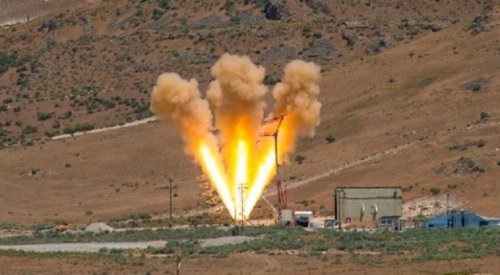Orbital ATK successfully tested a motor used for the Orion spacecraft’s abort system Thursday.
The brief test of the motor, at a company facility in Utah, demonstrated its ability to pull the Orion away from an SLS in an emergency.
This test, designed to confirm the performance of the motor in higher temperature conditions, is the first of three such tests planned. [Deseret News]
More News
A Progress cargo spacecraft docked with the International Space Station on schedule this morning. The Progress MS-06 spacecraft docked with the Zvezda module at 7:37 a.m. Eastern, two days after launch from Baikonur. The spacecraft brought more than three tons of cargo, ranging from food to fuel, to the station. [NASASpaceFlight.com]
Senators approved an amendment to a sanctions bill to ensure continued access to Russian rocket engines for civil and commercial launches. The amendment was introduced after concerns language in an Iran-Russia sanctions bill being debated by the Senate could prevent the purchase of engines used by the Atlas 5 and Antares rockets for non-defense missions. The amendment provides an exception to proposed sanctions for engines and other services related to civil and commercial launches. The bipartisan amendment passed 94-6 despite criticism of it on the Senate floor by Sen. John McCain (R-Ariz.). The full bill passed 98-2 and goes to the House. [SpaceNews]
SpaceX is now planning a Monday launch of a Falcon 9 after a static-fire test late Thursday. SpaceX said the static-fire test, part of routine pre-launch preparations, was a success, with the launch now scheduled for Monday afternoon. The launch of the BulgariaSat-1 communications satellite was scheduled for Saturday, but delayed when launch preparations fell behind schedule. Weather forecasts were also unfavorable for a weekend launch. [Spaceflight Now]
The Canadian government is facing criticism after approving the sale of a satellite technology company to a Chinese firm. The government recently approved the sale of Norsat International to Hytera Communications Corp. of Shenzhen, an approval Canadian Prime Minister Justin Trudeau said came after consultation with the United States and other allies that purchase equipment from Norsat. Members of the opposition in parliament, though, argued the sale was not in national interests. Separately, Norsat has received a higher bid from a U.S.-based investment fund, which Hytera has until June 20 to match. [SpaceNews]
A Chinese satellite has set a new record for communications using quantum entanglement. Chinese scientists used the Micius satellite, launched last August, to transmit entangled photons to two ground stations 1,200 kilometers apart. The test is the latest milestone in efforts at quantum communications, which could provide ultra-secure communications. [Science]
One of the leading providers of satellite connectivity for aircraft said it’s unclear if such services can be profitable in the long run. David Bruner, vice president of global sales and marketing for Panasonic Avionics, said demand for such services is not a problem, but downward pricing pressure is making it difficult for service providers like his to make much money on those services. Despite those issues, Panasonic Avionics is moving ahead with plans to increase services, including leasing capacity on the newly-launched Eutelsat-172b satellite to serve customers in the Asia-Pacific region. [SpaceNews]
Airbus is looking at ways to accommodate multiple satellite antennas on its airliners. Mark Rich, vice president of Airbus’ connected fleet division, said that one way to address reliability concerns for in-flight connectivity would be to have multiple antennas from different providers on the same plane. New technologies, such as flat-panel antennas that conform more closely to the aircraft’s body, could enable those plans. [SpaceNews]
A Chinese cargo spacecraft has completed a second on-orbit refueling test. The Tianzhou-1 transferred fuel to the Tiangong-2 module, to which it has been docked since April, during the test this week. Tianzhou-1 will later undock from the module and fly around it before docking again with the module. Chinese officials said those tests are key steps in plans for its permanent space station it plans to have in operation by the early 2020s. [Xinhua]
Wednesday’s Progress launch triggered a fire hundreds of kilometers away that killed one person. Fragments of the first stage of the Soyuz rocket that launched the Progress spacecraft fell in a designated drop zone 600 kilometers form Baikonur, and the hot, windy conditions there helped fan a wildfire. One worker with NPO Mashinostroyenia, which maintains the drop zones, was killed responding to the fire, which was later contained. [Space.com]
Astronomers have selected the first set of targets for the James Webb Space Telescope. The observations will be part of “Guaranteed Time Observations” available to astronomers who helped developed the observatory’s instruments. The planned observations range from the outer planets in our solar system and small Kuiper Belt objects to exoplanets like TRAPPIST-1e and distant galaxies in the young universe. Those observations will take place in the first two years of operations after JWST’s launch in late 2018. [Space Telescope Science Institute]
- Intelsat ends debt swap efforts, likely leading to a collapse of its planned merger with OneWeb
- The Moon is the gateway to NASA’s exploration future
- Cruz interested in updating Outer Space Treaty to support commercial space activities
- China launches first cargo spacecraft on mission to test docking and refueling
- A short history of lunar space tourism
Share with your friends

(0) Comments
This article comments are currently no :(